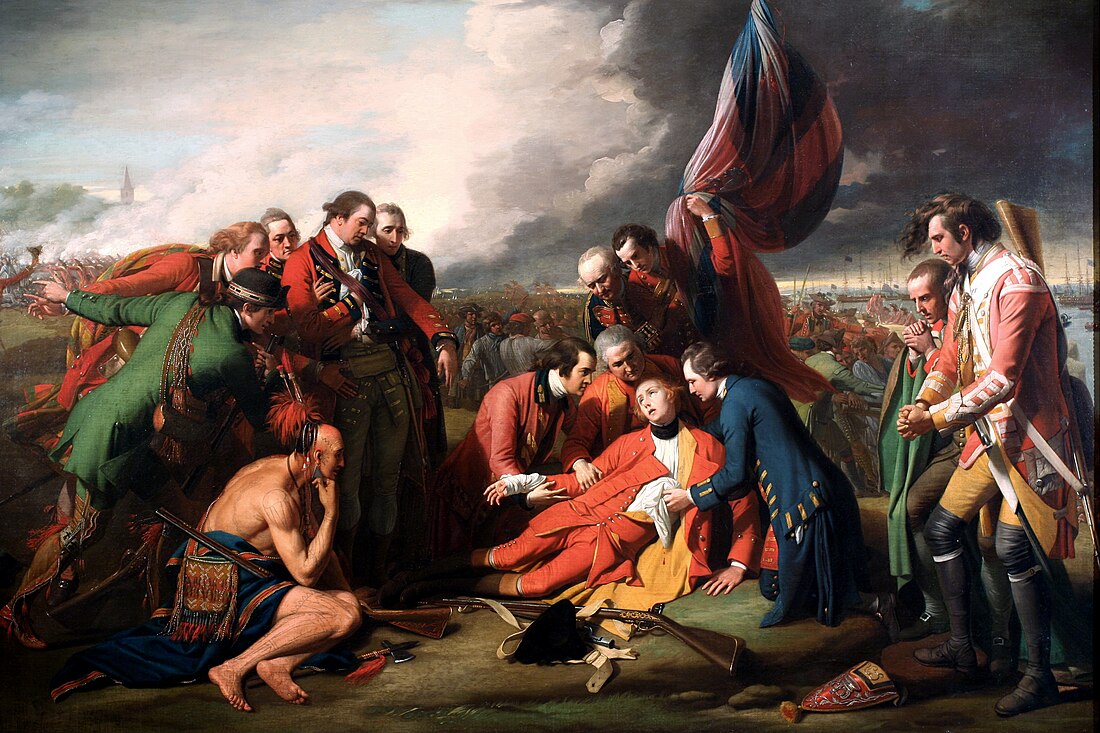Events from the year 1727 in Canada.
This article needs additional citations for verification. (July 2016) |
Incumbents
- French Monarch: Louis XV[1]
- British and Irish Monarch: George I (died June 11),[2] George II (starting June 11)[3]
Governors
Events
This section is empty. You can help by adding to it. (March 2013) |
Births
- January 2 - James Wolfe, British Army officer (died 1759)[4][5]
- February 7 - Charles Deschamps de Boishébert et de Raffetot, military (died 1797)[6]
- March 23 - Philippe-François de Rastel de Rocheblave, soldier, businessman and political figure in Lower Canada (died 1802)
Deaths
- November 10 - Alphonse de Tonty, officer (born 1659)[7]
- December 26 - Jean-Baptiste de La Croix de Chevrières de Saint-Vallier (born 1653)[8]
Historical documents
Nova Scotia councillor is present as Nanrantsouak and other nations ratify peace treaty and discuss issues with New England leaders[9]
Ratification article obliges all parties, settler and Indigenous, to send fighters for united response to attack on any party[10]
Nova Scotia Council reviews letter from Councillor Mascarene on ratification, including "mutual assistance" article[11]
Lt. Gov. Dummer will invoke mutual assistance to get Penobscot to pursue Cape Sable Indigenous people who attacked boats[12]
Dummer and Nanrantsouak chief sachem discuss return of British settlers taken by Indigenous people[13]
Indigenous people note price increase for goods they want and decrease for beaver, and Dummer explains "the Nature of Markets"[14]
Report that "Cape Sable Indians" killed all aboard vessel, danced on shore around their scalps and took some to Louisbourg[15]
"Antimonarchical" Bostonians with Acadians undermine Nova Scotia government and incite Indigenous attack (Note: "savages" used)[16]
Nova Scotia Council decides French "up the Bay" of Fundy refusing to swear allegiance will not be dealing with "our English Traders"[17]
Acadian Deputies insist that oath have clauses allowing free exercise of religion, exemption from military, and property rights[18]
For refusing unconditional oath to King George II, Acadian Deputies are imprisoned and inhabitants prohibited from fishing[19]
Questioning Indigenous men from local regions about reported murder, Council invokes their treaty obligation to make amends[20]
Nova Scotia governor calls for troops at Minas and Chignecto, for Canso fort, and setting up military recruits as settlers after four-year tour[21]
Detailed proposal to grant poor people 50 acres, craftsmen 100 acres and "substantial inhabitants" 1,000 in Nova Scotia (Note: "savage" used)[22]
Much Nova Scotia fish (and most from Canso) sold in Île-Royale, which is also "constantly supply'd from Boston with all sorts of commodities"[23]
Merchants complain about high-handed Placentia commander taking best fishing places, overcharging for goods and abusing people[24]
Newfoundlanders spend winter cutting boards, making oars, building and repairing boats, and repairing structures, while others hunt[25]
Newfoundland shore fish preferable to Grand Banks fish because latter are "in bulk before[...]wash'd out, and is broke [before] spread"[26]
British have right to oppose French at Niagara because Six Nations in "entire subjection to H.M. did surrender all their lands to him"[27]
New York is building "stone house of strength" at Oswego, "lying most conveniently to receive all the far Indians who come to trade with us"[28]
N.Y. General Assembly praises governor's "zeal for[...]securing the Six Nations in the British interest" by building Oswego trading house[29]
Very few "Adirondacks" remain after Six Nations victories, and are not "of any consequence, either in Peace or War" (Note: racial stereotypes[30]
Montreal priest admonishes apostasy of woman gone to New England, citing Catholic doctrine and censuring Protestantism[31]
Devonshire man seeks New England posting as "reward for[...]taking seven sail of sloops etc. manned by Indians who attacked" Canso fishery[32]
"Melancholy, distressful, horrid" - Few survive 12 days at sea in boat without drinking water before reaching Newfoundland[33]
Unusually, this news (that French army will put Louis XV's father-in-law on Polish throne) comes to New York by way of Île-Royale and Canso[34]
References
Wikiwand in your browser!
Seamless Wikipedia browsing. On steroids.
Every time you click a link to Wikipedia, Wiktionary or Wikiquote in your browser's search results, it will show the modern Wikiwand interface.
Wikiwand extension is a five stars, simple, with minimum permission required to keep your browsing private, safe and transparent.


